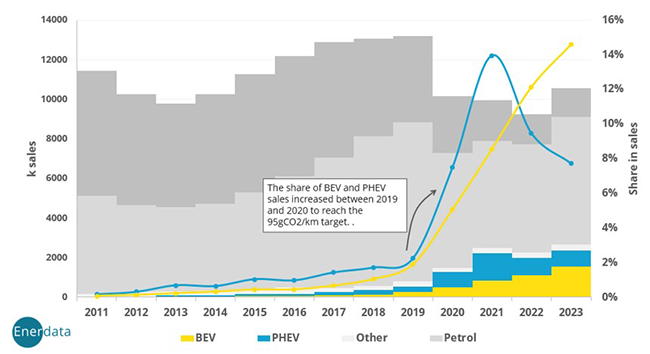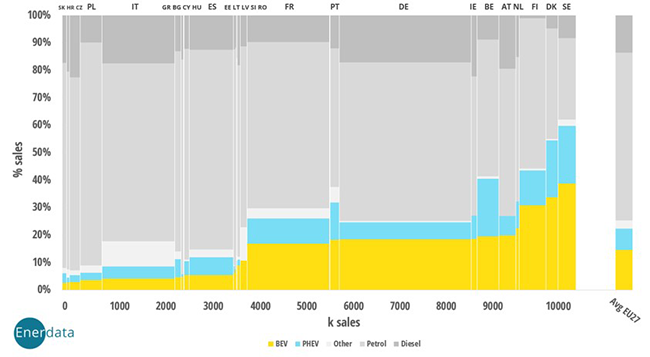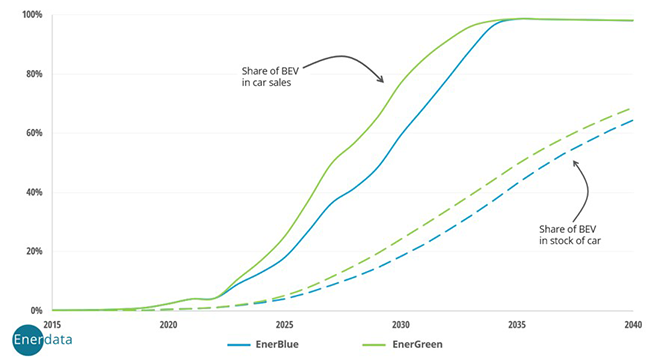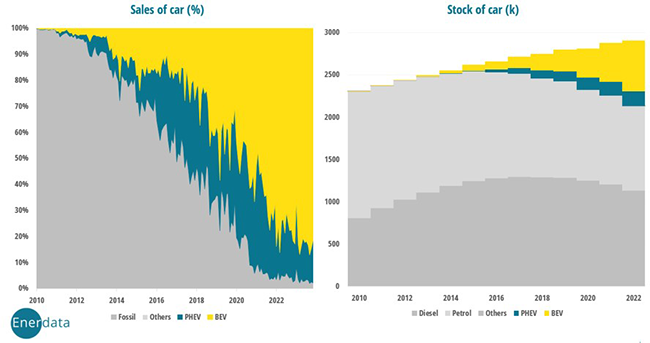See also

EV: Sales, underlying policies, impacts
Get this executive brief in pdf format
The European Union (EU) has set a target of carbon neutrality by 2050, in line with the Paris Agreement, as well as an intermediate target of a net reduction in domestic greenhouse gas (GHG) emissions of at least 55% by 2030 compared to 1990.
Road transport plays a key role in achieving these targets. Amid a recently slowing appetite for electric car sales and the introduction of modest price cars from Asian manufacturers, this executive brief explores the factors driving the sales of electric vehicles (EVs) in the EU. After an overview of the regulatory landscape for road mobility, we present recent and expected trends in electric car sales and possible implications for the electricity grid. An analysis of Norway's exemplary approach to fostering EV adoption is also discussed.
Legislation: tightening CO2 emission standards for cars and vans
On 19 April 2023, in line with the EU’s increased climate ambition and in the framework of the Sustainable and Smart Mobility Strategy, the European Parliament and the Council agreed to strengthen the CO2 emission performance standards for new passenger cars and new light commercial vehicles1. The objective is to achieve a 100% reduction in average emissions in 2035 for cars and vans, with two intermediate stages of: -15% in 2025 and -55% in 2030 for cars and -50% in 2030 for vans, compared to 2021. These two amendments were voted to complete a legislation which imposed an emission level of 95 gCO2/km on average for the new car fleet for the year 2020. This latter target was expressed according the old NEDC standard2. Figure 1 illustrates the evolution of European emissions targets based on the latest WLTP standard.

Figure 1 : Observed unit emissions for new cars and targets (WLTP)

Source: Enerdata, Odyssee – Values prior to 2020 (the year in which the NEDC standard was changed to the WLTP standard) are recalculated according to the WLTP standard
The 2030 and 2035 targets were set to ensure that the automotive sector contributes to the EU’s climate objectives and to stimulate innovation. This objective can only be achieved by gradually replacing combustion engine vehicles with zero-emission vehicles. By 2035, the deployment of electric technology is likely to take precedence over alternative technologies, for which many questions remain: development of hydrogen fuel cell cars is conditioned to large deployment of a green hydrogen supply and refuelling infrastructure, development of synthetic and bio-sourced fuels is slow and uncertain3.
A boost in electric car sales pushed by EU emission targets
The total car fleet in the EU represents around 290 million vehicles in 2023. Around 18 million (5.5% of the stock) are powered by alternative fuels (i.e. other than diesel or gasoline). About half of this alternative-fuel vehicles are electric or hybrid, while the other half are powered by LPG, CNG, LNG and hydrogen4. Germany has the largest electric vehicle fleet, with almost 1.5 million vehicles, followed by France with 1 million, the Netherlands (465,000) and Sweden (330,000).
In the EU, the car market has remained fairly stable since 2010, with ~10 to 13 million vehicles sold on average every year, with a slight increase between 2016 and 2019 (Figure 3). 2020 represents a turning point with a 33% fall in total sales (thermal and alternative vehicles), mainly due to the COVID pandemics. The market size has remained at a similar level since then. In 2023, cars sales increased by 15%, recuperating from a semiconductor supply crisis in 2022, but remaining well below the 2019 peak.
Concerning the EVs market, the 2020 target of 95 gCO2/km (NECP) for the average new fleet and the risk of heavy fines in case of non-compliance have encouraged car manufacturers to promote the sales of electric and plug-in hybrids models. As a result, the share of electric and hybrid cars in the EU has increased from 4% of sales in 2019 to more than 12% in 2020.
Figure 2: Car sales by technology in EU between 2011 and 2023

Source: Enerdata, Odyssee, ACEA
Today, although thermal vehicles still account for the majority of sales, their share is falling sharply (from almost 100% in 2011 to 73% in 2023). This decline is even more marked for diesel cars, which have fallen from 55% of total sales in 2012 to only 12% in 2023, due to the recent increase in taxation of this fuel in some EU countries, the Dieselgate scandal (2015) and driving restriction in multiple Europeans cities.
Since 2020, the share of electric cars (BEV) has increased steadily to reach 15% of total sales in 2023, while the share of plug-in hybrids has peaked to 14% in 2021 and decreased thereafter (8% in 2023 (Figure 2)). The main models sold in 2022 were Tesla and Volkswagen, the main players in the EV markets.
In addition to regulatory standards, the EV market also depends on the infrastructure of recharging station. EU law requires fast-charging stations at every 60 kilometres by the end of 2025. The number of public charging points grown rapidly in recent years, with average annual growth of 53% since 2020. At the end of 2023, there were 650,000 charging points in the EU (European Alternative Fuels Observatory).
Market trends for electric vehicles across Europe vary considerably from one Member State to another. For example, electric vehicles account for just 3% of sales in Slovakia, compared with 39% in Sweden (Figure 3). These differences between countries can be explained by the different average income levels of the population, electric vehicles being more expensive to buy on average. They can also be explained by varying levels of national support for electric vehicles. For example, BEV sales in Portugal accounted for 18% of total sales in 2023 thanks to a significant reduction in taxes for individuals and businesses, and a reduction in parking costs. By comparison, in Spain, BEV sales accounted for 10% of total sales in the same year.
Figure 3: Car sales per EU country in 2023

By 2035, electric cars could reach half of the total EU27 fleet
The early-2024 context for electric cars is stagnating in terms of sales (only 11.5% of market share in January-February 2024, compared to 10.8% a year ago). However, the arrival of cheaper electric car models in Europe combined with the still-active long-term EU objective to 2035 can be expected to accelerate the sales in the following years.
Thanks to its expertise in energy scenario modelling, Enerdata produces annual scenario outlooks through its EnerFuture service5, to analyse energy markets dynamics and links with climate policies and climate change. The scenario achieving the latest NDCs (submitted by the end of 2023) is called EnerBlue, while the well-below 2-degree scenario is called EnerGreen.
Regarding the EU market for electric cars, in the EnerBlue scenario, electric cars in EU 27 reaches 60% of total sales in 2030 and 99% in 2035 (with conventional motors totally phased out by this date). This represents a fleet of 50 million electric cars in 2030, about a fifth of the total. By 2035, there would be around 110 million electric cars on EU27 roads, i.e. 43% of the total car fleet.
The shift to electric cars is even faster in the EnerGreen scenario, which projects 77% electric cars in EU27 market shares in 2030; this represents a stock of 80 million electric cars in 2030, or about a quarter of the total car stock. By 2035, there would be around 122 million electric cars on the EU27 roads, i.e. half of the total stock (Figure 4).
Figure 4: Share of electric cars – new cars and car stock in EU27
EnerGreen and EnerBlue scenarios

Source: Enerdata - Enerfuture
This quick phase-in of electric cars creates a significant additional load for the power system. The required electricity production reaches 72 TWh in 2030 and 152 TWh in 2035 (EnerBlue scenario).
In 2035, this represents almost 5% of the annual electricity demand of the EU27, and this figure keeps increasing after 2035 as electric cars replace more and more thermal vehicles. This would represent a fictive average load of 17 GW on the EU27 scale. However, the charging load of electric cars is not constant, with peak loads observed in particular in the early evening, when peak demand is already putting pressure on the power grid.
The results presented here have uncertainties linked to the specific policy developments of each European country, as discussed in the Portuguese-Spanish example above.
Renewable incorporation in the car energy mix and CO2 emissions of electric cars in EU
Electricity used in cars contributes to raising the total share of renewable in car energy use to 21% by 2035 (of which 9% from biofuels and 12% from renewable electricity) in the EnerBlue scenario.
By comparison, the October 2023 update of the Renewable Energy Directive (RED III) sets an EU objective based on two choices: (i) reduce greenhouse gas intensity in transport by 14.5% by 2030 (compared to a baseline situation) or (ii) use 29% renewable energy in the transport sector as a whole by 2030. Given the higher efficiency of electric vehicles, the second objective is challenging and only a few countries reach it (Denmark, Ireland, Sweden, Belgium, Estonia, Latvia and Malta).
Thanks to the systemic approach of the Enerfuture scenarios, the power supply emissions consider the new demand from electric cars. The electricity emission factor drops from around 200 gCO2/kWh in 2023 to only 18 gCO2/kWh on a EU27 scale in 2035 (EnerBlue scenario). This means that almost half of the car stock (43%) would emit just 2.7 MtCO2 in 2035, representing 0.7% of road transport emissions. If the power system did not decarbonize, keeping the same emission factor as in 2023, these emissions would amount to 31 MtCO2. This shows the positive interactions of electrifying the economy and greening the electricity. One should note however that this analysis does not cover other dimensions such as raw materials and upstream emissions from car manufacturing.
The case of Norway
Norway is a country that has made great progress in the adoption of electric vehicles. In 2017, the Norwegian Parliament adopted a national target that all new cars sold by 2025 should be zero-emission vehicles. This was a very early step compared with other European countries. The development of the car market in Norway can be seen as an example of how energy consumption in Europe could evolve with an increasing share of BEVs in car sales.
EV support policy in Norway
Norway has a long history of electric vehicles' development, dating back to the 1990s. Over the past 30 years, zero emissions vehicles have benefited from a series of taxes and regulatory advantages, such as reductions or exemptions from VAT, purchase tax and road tax. These regulations were implemented to boost the economic competitiveness of EVs compared with internal combustion engine (ICE) cars. The strategy was to provide an opportunity for this new technology, with the expectation that the cost of batteries would decrease over time as production increased.
All these incentives paid off 20 years later. EVs sales began to rise significantly in the early 2010s, as the technology matured. Over the past two years, EVs steadily held more than 80% of market shares. EVs represent today 20% of the car fleet (see Figure 5).
Figure 5: Evolution of sales and stock of car in Norway

Source: Enerdata, Odyssee, SSB and Enerdata calculations
Most of the economic incentives were phased out around 2017, as electric car prices have plummeted in the last decade, and the government is focusing on other aspects impacting the development of the EV fleet, such as the charging infrastructure. For example, the Parliament voted in 2017 on the “right to charge” procurement, ensuring that people renting apartments can install charging infrastructure at home.
Examples of regulation advantages:
- No purchase/import tax on EVs (1990-2022). From 2023 some purchase tax based on the cars’ weight on all new EVs
- Exemption from 25% VAT on purchase (2001-2022). From 2023, Norway will implement a 25% VAT on the purchase price from 500 000 Norwegian Kroner and over.
- No annual road tax (1996-2021). Reduced tax from 2021. Full tax from 2022.
- No charges on toll roads (1997- 2017). Maximum 50% of the total amount on toll roads (2018-2022). From 2023, 70%.
- No charges on ferries (2009- 2017). Maximum 50% of the total amount on ferry fares for electric vehicles (2018)
- Free municipal parking (1999- 2017)
Impact on energy consumption
In 2022, Norway produced 146 TWh of electricity, 88% of which was hydroelectric. This enormous hydropower capacity has been the backbone of EV development since its premises, ensuring a steady and CO2-free production capacity. The share of electric production allocated for the transportation sector was around 2 330 GWh in 2022 (around 2% of total consumption). Projection scenarios (2016) estimated that the 2025 full ZEV sales target should lead to a 1,5 million BEVs in Norway in 2030. This would lead to an increase of 4 TWh electricity consumption, which is only 3% of the current total electricity consumption. In addition, a back-of-the-envelope calculation shows that if the car fleet had remained 100% oil-fuelled, Norway would have consumed between 14% and 18% more for car transport in 2022 (about 45 TWh instead of 39 TWh, see figure 6). Over the last ten years, Norway has saved about 25 TWh of oil thanks to the development of electric cars.
Figure 6: Energy consumption of cars

Source: Enerdata, Odyssee, SSB and Enerdata calculations
Thus, the risk of insufficient electricity production in Norway is not a concern. More risks lie in terms of power demand due to uncoordinated charging. Norway is one of the countries with the highest availability of home charging in the world. For now, 80% of owners tend to charge their cars at home, mostly during the night. In the future, it could create local overloads if EV owners charge their cars at the same time during peak demand, especially in loosely connected areas.
The challenge now for Norway is to encourage residents to charge their vehicles throughout the day. The public charging network is already widely deployed, with almost 24,000 public charging stations. It is the second country with the highest number of charging points per inhabitant in Europe (over 4 stations per 1,000 inhabitants, more than twice the EU average). The challenge for Norway now lies primarily in promoting changes in user behaviour. We look forward how this pioneering country can show the way to other European countries…
Conclusion
In conclusion, the EU's stringent emissions standards and the introduction of more affordable electric car models have catalysed a significant shift in the automotive market. The increase in electric car sales from less than 2% in 2019 to 15% in 2023 underlines this shift. If current targets are maintained, projections suggest that almost half of the car fleet could be electrified by 2035.
In Norway, ambitious support policies have driven electric vehicle sales from less than 5% in 2013 to nearly 90% in 2023, resulting in significant oil savings of around 25 TWh over the past decade. This result is a first real-life assessment of the potential impact of European targets on the decline in oil consumption, which could accelerate significantly over the next decade. However, this acceleration depends on the EU government's support for these policies, as shown in the Norwegian example.
Notes
- Source : EUR-lex
- These emission levels are now calculated using the Worldwide Harmonized Light Vehicles Test Procedure (WLTP). In 2020, this new standard superseded the old NEDC (New European Driving Cycle) standard, which no longer reflected today's driving profiles, vehicle performance and road.
- The Directive of 19 April 2023 provides for a progress report by the end of 2025, in which the European Commission will examine the progress made in terms of synthetic fuels.
- Source : Vehicles and fleet | European Alternative Fuels Observatory (europa.eu)
- Enerfuture service
 Energy and Climate Databases
Energy and Climate Databases Market Analysis
Market Analysis